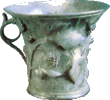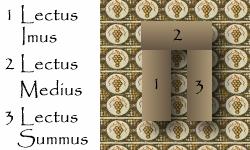|
The triclinium, or dining room, took its name from the
three couches on which family members and their guests lounged
to take their meals.
Each couch was wide enough to accommodate three diners who
reclined on their left side on cushions while some household
slaves served multiple courses rushed out of the culina, or
kitchen and others entertained guests with music, song or
dance.
Marcus Vitruvius Pollio, in his book, de
Architectura, describes the triclinium: "The length of a
triclinium is to be double its breadth. The height of all
oblong rooms is thus regulated: add their length and breadth
together, of which take one half, and it will give the
dimension of the height. If, however, exedræ or oeci are
square, their height is equal to once and a half their width.
Pinacothecæ (picture rooms), as well as exedræ, should be of
large dimensions. The Corinthian tetrastyle and Egyptian oeci
(halls) are to be proportioned similarly to the triclinia, as
above described; but inasmuch as columns are used in them,
they are built of larger dimensions."
He goes on to direct the orientation of triclinia according
to the seasons: "Winter triclinia and baths are to face the
winter west, because the afternoon light is wanted in them;
and not less so because the setting sun casts its rays upon
them, and but its heat warms the aspect towards the evening
hours....Spring and autumn triclinia should be towards the
east, for then, if the windows be closed till the sun has
passed the meridian, they are cool at the time they are wanted
for use. Summer triclinia should be towards the north, because
that aspect, unlike others, is not heated during the summer
solstice, but, on account of being turned away from the course
of the sun, is always cool, and affords health and
refreshment." 
The social status of diners would immediately be apparent
upon entering the triclinium. Each of the three couches in the
triclinium carried significant social standing, as did the
three positions on the couch. The lectus imus was the master's
couch, and he assumed the locus summus. To his immediate right
was the locus medius, and farthest from him on the couch was
the locus imus. Members of the host's own family, if they
dined with him, usually reclined with him on this couch, which
held the least status. 
Guests were positioned on the other two couches at the
master's discretion and according to their social standing. To
his immediate left was the lectus medius, and the third
position upon that couch, the locus imus, was the place of
honour, or locus consularis. The guest placed here had the
greatest access to the host.
References: Handbook to
Life in Ancient Rome, Lesley
Adkins and Roy A. Adkins (Oxford University Press, 1998); The
Romans, their Life and Customs, E. Guhl and W. Korner, Senate
Press, 1994
|
